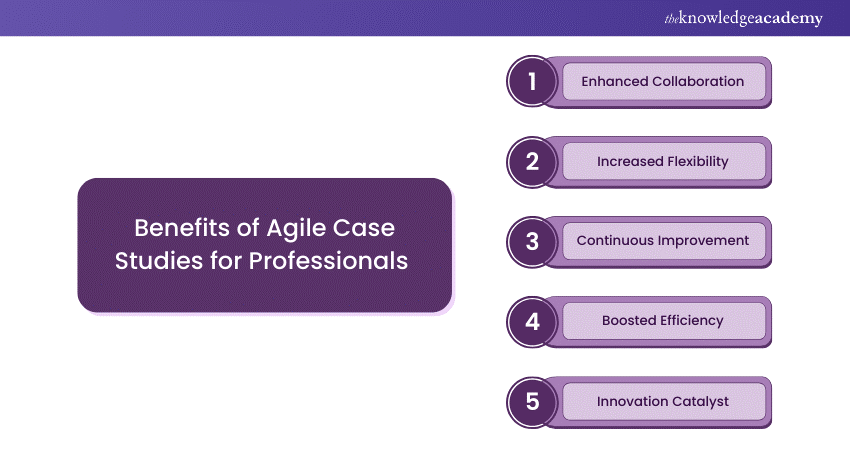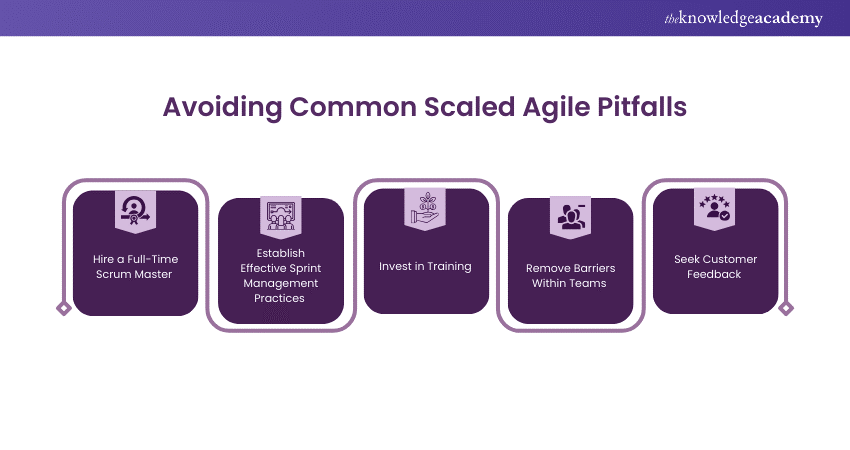We may not have the course you’re looking for. If you enquire or give us a call on +65 6929 8747 and speak to our training experts, we may still be able to help with your training requirements.
Training Outcomes Within Your Budget!
We ensure quality, budget-alignment, and timely delivery by our expert instructors.

Agile Methodology is all about being flexible, working together, and always improving in Project Management. Organisations all over the world have embraced its principles, boosting innovation and efficiency in many industries. In this blog, we dive into interesting Agile Case Studies to show how different companies have used Agile to achieve great results and tackle tough challenges.
Table of Contents
1) Agile Case Study: Overview
2) Who Uses Agile Methodology?
3) Benefits of Case Studies for Professionals
4) Agile Case Study Examples
5) Avoiding common scaled agile pitfalls
6) Conclusion
Agile Case Study: Overview
Agile Methodology has revolutionised the way organisations approach Project Management, fostering a culture of adaptability, collaboration, and continuous improvement. By breaking projects into manageable increments and emphasising regular feedback, Agile allows teams to deliver high-quality results efficiently. This guide explores various Agile case studies, providing insights into its real-world applications and benefits across different industries.
Who Uses Agile Methodology?
Agile Methodology extends far beyond the tech industry, finding application across a multitude of sectors. Its flexibility and effectiveness have made it a favoured approach not only among IT giants and software development firms but also within educational institutions and service providers. Companies like Panera Bread, Dell, and Arizona State University (ASU) have successfully implemented Agile principles to optimise their operations, boost team performance, and ensure timely, budget-friendly project delivery.
Understand Agile principles for adaptable and responsive Project Management with our Agile Project Management Foundation & Practitioner (AgilePM®) Training – register today!
Benefits of Case Studies for Professionals
Agile Methodology emphasises flexibility, collaboration, and continuous improvement in project management. Organisations worldwide have adopted its principles, driving innovation and efficiency across various industries. In this guide, we explore compelling Agile case studies, demonstrating how different companies have successfully implemented Agile to achieve remarkable results and overcome complex challenges.
Key Points:

a) Enhanced Collaboration: Agile promotes teamwork, ensuring all stakeholders are aligned and contributing effectively.
b) Increased Flexibility: Agile allows organisations to adapt quickly to changes, ensuring they remain competitive and responsive.
c) Continuous Improvement: Through regular feedback and iterative processes, Agile fosters an environment of ongoing enhancement and refinement.
d) Boosted Efficiency: By streamlining processes and eliminating unnecessary steps, Agile improves overall productivity and efficiency.
e) Innovation Catalyst: Agile's emphasis on creative problem-solving and adaptive planning sparks innovation, leading to groundbreaking solutions.
Learn how to become an effective Project Manager with our Certified Professional in Agile Project Management (CPAPM) Course – sign up now!
Agile Case Study Examples
Here are some Agile Case Studies for you to understand the methodology better:
1) Panera Bread
Panera Bread, with its extensive network of over 1,700 bakery-cafés in North America, faced a challenging year in 2013. The unpredictable market and their own rapid expansion demanded a fresh approach to business strategies, emphasising the need for swift software development and deployment throughout their locations.
To tackle this, Panera initiated a series of hands-on agile training workshops. They didn’t stop there; they brought in expert agile coaches to guide the launch of key projects under the Disciplined Agile Delivery (DAD) framework. The success of these initial projects led to Panera adopting DAD across the entire organisation.
This strategic move to scale up DAD paid off, leading to quicker and more reliable delivery of top-notch solutions. One notable achievement was the introduction of an improved mobile ordering system. This revamped online service has been a hit, now making up 25% of Panera’s total sales.
2) Dell
Dell, a global leader in technology solutions, utilised Agile to transform its product development processes. Faced with the need to accelerate time-to-market and enhance product quality, Dell adopted Scrum and Kanban methods. This shift allowed for greater transparency, improved communication among cross-functional teams, and more efficient management of complex projects. The Agile approach enabled Dell to respond swiftly to market demands and deliver innovative products consistently.
Explore the real benefits of Agile for your team. Check out our comprehensive blog on Agile!
3) Moving towards Agile: Managing Loxon Solutions
Loxon Solutions, a software company specialising in financial solutions, transitioned to Agile to improve its project delivery and client satisfaction. The move involved extensive training, restructuring of teams, and the implementation of Scrum. As a result, Loxon experienced shorter development cycles, better alignment with client requirements, and a more engaged and motivated workforce. The Agile transformation at Loxon serves as a testament to the methodology's ability to drive organisational change and success.
4) Improving Team Performance and Engagement
One of the core principles of Agile is fostering a collaborative and motivated team environment. Numerous case studies highlight how Agile practices have improved team performance and engagement. By promoting regular communication, transparency, and continuous feedback, Agile Methodologies help teams stay aligned with project goals and enhance their productivity. Teams feel more valued and empowered, leading to higher job satisfaction and lower turnover rates.
5) Ambidexterity in Agile Software Development (ASD) Projects
Ambidexterity, the ability to balance exploration and exploitation, is crucial in Agile software development projects. Case studies demonstrate how Agile methods like Scrum and Kanban facilitate this balance, enabling teams to innovate while maintaining operational efficiency. Organisations that successfully implement ambidextrous practices within Agile projects can better navigate market changes and sustain long-term growth.
Unlock your potential and drive your career forward with our SAFe Agile Certification!
6) Agile and Generic Work Values of British vs Indian IT Workers
Xcel Energy successfully overcame a significant hurdle to fulfill the Southwest Power Pool’s reliability requirements in New Mexico. They pledged to build a new 34-mile, 345-kilovolt transmission line, sticking to a tight budget of $65 million and a set deadline, all while complying with the Bureau of Land Management’s environmental standards. This was a test of Xcel Energy’s Project Management and resource distribution skills.
Resolution:
Xcel Energy brought on board a seasoned PM Solutions consultant who specialised in Project Management within the utility sector. This consultant seamlessly blended into Xcel’s Project Management team, applying their extensive knowledge to offer strategic advice and direction.
Here’s how they tackled the challenge:
1) Employed collaborative and interpersonal skills to overcome obstacles and minimise risks.
2) Prioritised the identification and resolution of potential issues to keep the project on track.
3) Organised meetings with vendors, designers, and construction teams to enhance teamwork and communication.
4) Kept a close watch on the delivery of critical equipment to avoid delays.
5) Regularly visited the field to monitor design and construction progress.
6) Diligently tracked budget estimates, actual expenditures, and change orders to manage finances.
7) Supported various departments in fulfilling their roles and overcoming hurdles.
The result was remarkable: the project wrapped up eleven days early and saved nearly £ 3.16 million, well below the budget. The management team hailed this achievement as it met every technical and quality benchmark set out from the start.
7) Arizona State University (ASU)
Arizona State University (ASU) adopted Agile Methodologies to enhance its IT services and Project Management practices. By implementing Scrum, ASU improved its project transparency, fostered better communication among stakeholders, and accelerated its project delivery timelines. This transition not only improved operational efficiency but also enhanced the overall student and faculty experience.
Thinking about Agile? Learn how it can impact your organization in our full guide to Agile Transformation.
8) £ 51.29 Million Electric Utility Project Completed Ahead of Schedule and Under Budget
A remarkable example of Agile's effectiveness is a £ 51.29 million electric utility project that was completed ahead of schedule and under budget. By employing Agile practices such as iterative planning, continuous feedback loops, and collaborative team efforts, the project team was able to navigate complex challenges and deliver exceptional results. This case study underscores Agile's potential to drive success in large-scale, high-stakes projects.
Avoiding Common Scaled Agile Pitfalls
Know how to avoid common Agile Pitfalls:

1) Hire a Full-Time Scrum Master
One of the common pitfalls in scaling Agile is the failure to dedicate a full-time Scrum Master. A Scrum Master plays a crucial role in facilitating Agile processes, removing impediments, and ensuring the team adheres to Agile principles. Organisations should invest in hiring and training full-time Scrum Masters to provide the necessary support and guidance for successful Agile implementation.
2) Establish Effective Sprint Management Practices
Effective sprint management is essential for Agile success. Teams should focus on clear sprint planning, regular stand-ups, and thorough sprint reviews. Proper sprint management practices ensure that teams stay on track, identify issues early, and continuously improve their processes. This approach fosters a culture of accountability and continuous improvement.
3) Invest in Training
Investing in Agile training for all team members is critical to avoid common pitfalls. Comprehensive training programs help teams understand Agile principles, roles, and practices. Well-trained teams are better equipped to implement Agile effectively, adapt to changes, and drive project success. Continuous learning and development should be encouraged to keep skills up-to-date and relevant.
4) Remove Barriers Within Teams
Removing barriers within teams is essential to maintain Agile momentum. Organisational silos, communication gaps, and hierarchical constraints can hinder Agile practices. By fostering a culture of openness, collaboration, and trust, organisations can eliminate these barriers and create an environment where Agile can thrive. Encouraging cross-functional teams and promoting transparency are key strategies to achieve this.
5) Seek Customer Feedback
Customer feedback is at the heart of Agile Methodology. Regularly seeking and incorporating customer feedback ensures that the product meets user needs and expectations. Agile teams should establish effective feedback mechanisms, such as user testing, surveys, and direct customer interactions. This iterative approach allows for continuous improvement and delivers products that truly resonate with customers.
Conclusion
Agile methodology has revolutionised the way organisations operate across various industries. The Agile Case Studies discussed in this blog showcase how Agile drives efficiency, boosts team performance, and delivers high-quality results. By learning the benefits and potential pitfalls of Agile, professionals can more effectively implement its principles and achieve organisational success.
Enhance your collaboration skills with our Agile Training – join now!
Frequently Asked Questions

The term “Agile” with upper case “A” refers to a methodology developed for software projects.

Yes, use cases are used in Agile. They define functional requirements by describing user interactions with the system. Often written as user stories, use cases help Agile teams understand user needs, prioritise work, and plan iterations.

The Knowledge Academy takes global learning to new heights, offering over 30,000 online courses across 490+ locations in 220 countries. This expansive reach ensures accessibility and convenience for learners worldwide.
Alongside our diverse Online Course Catalogue, encompassing 17 major categories, we go the extra mile by providing a plethora of free educational Online Resources like News updates, Blogs, videos, webinars, and interview questions. Tailoring learning experiences further, professionals can maximise value with customisable Course Bundles of TKA.

The Knowledge Academy’s Knowledge Pass, a prepaid voucher, adds another layer of flexibility, allowing course bookings over a 12-month period. Join us on a journey where education knows no bounds.

The Knowledge Academy offers various Project Management Courses, including the Earned Value Management Foundation and Practitioner Course, and the Scrum Certification. These courses cater to different skill levels, providing comprehensive insights into Types of Agile Methodology.
Our Project Management Blogs cover a range of topics related to Agile Management, offering valuable resources, best practices, and industry insights. Whether you are a beginner or looking to advance your Agile Management skills, The Knowledge Academy's diverse courses and informative blogs have got you covered.
Upcoming Project Management Resources Batches & Dates
Date
 Agile Project Management Foundation & Practitioner (AgilePM®)
Agile Project Management Foundation & Practitioner (AgilePM®)
Mon 10th Feb 2025
Mon 19th May 2025
Mon 14th Jul 2025
Mon 1st Sep 2025
Mon 27th Oct 2025
Mon 15th Dec 2025







 Top Rated Course
Top Rated Course



 If you wish to make any changes to your course, please
If you wish to make any changes to your course, please


